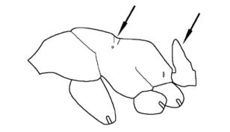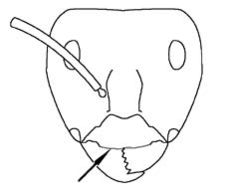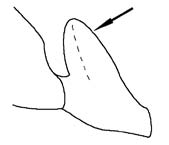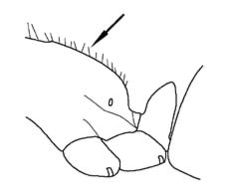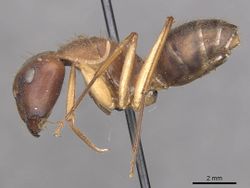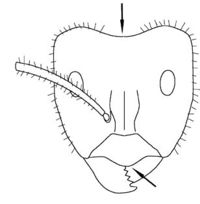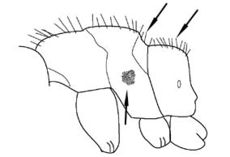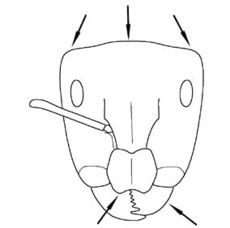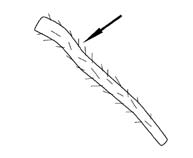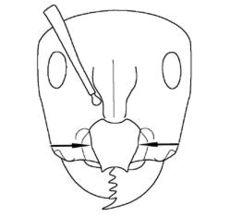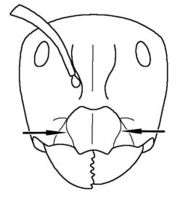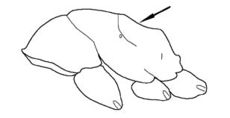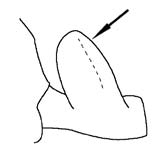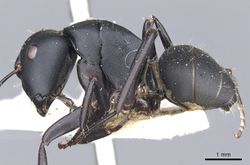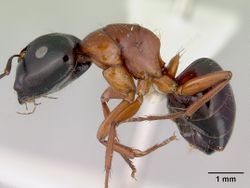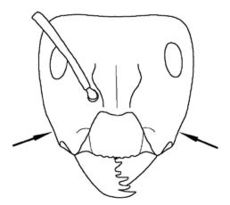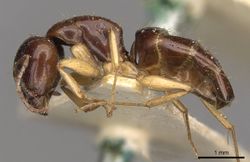Key to Australian Camponotus majors of the southwestern Botanical Province
This key to major workers is based on: Heterick, B. E. 2009a. A guide to the ants of South-western Australia. Records of the Western Australian Museum, Supplement 76: 1-206. Part 1.
Since the publication of this key the genus Colobopsis has been removed from its synonymy with Camponotus. Colobopsis species are therefore included in this key.
Heterick notes: Major workers This key provides couplets to known major workers: major workers for a number of species are as yet unknown, as this subcaste tends to leave the nest less frequently than the minor and media worker castes.
There is also a key to minors.
You may also be interested in
1
- Inner surfaces of middle and hind tibiae lacking elongate setae (Figure 186a); anterior two thirds of clypeus and surrounding genae abruptly truncate (used by the ant to plug the nest entry hole in wood) (Figure 186b) . . . . . (C. macrocephalus species-group) . . . . . Colobopsis gasseri
 Colobopsis gasseri major |
- Inner surfaces of middle and hind tibiae with double row of stout spines (Figure 187); clypeus and adjoining sectors of head capsule not as above . . . . . 2
2
return to couplet #1
- Mentum with elongate, J-shaped setae near its posterior margin (C. wiederkehri species-group) (Figure 188) . . . . . 3
- Without elongate J-shaped setae on posterior margin of mentum (Figure 189) . . . . . 9
3
return to couplet #2
- Antennal scape and tibiae with many erect, bristly setae . . . . . 4
- Antennal scape and tibiae lacking erect, bristly setae . . . . . 5
4
return to couplet #3
- Dorsum of petiolar node bluntly rounded, node thick (Figure 190a); pubescence on gaster abundant, individual setae overlapping (Figure 190b . . . . . Camponotus gouldianus
 Camponotus gouldianus major |
- Dorsum of petiolar node acuminate in profile, node thin, scale-like (Figure 191a); pubescence on gaster less abundant, individual setae usually not overlapping (Figure 191b) . . . . . Camponotus terebrans
 Camponotus terebrans major |
5
return to couplet #3
- In profile, posterior angle of vertex acute, relatively sharp; outline of mesosoma almost circular in outline (Figure 192) . . . . . Camponotus postcornutus
 Camponotus postcornutus major |
- In profile, posterior angle of vertex obtuse, smoothly rounded; outline of mesosoma not as above (pronotum is convex, mesonotum and dorsal surface of propodeum form a straight line, except for impression of metanotal groove) (Figure 193) . . . . . 6
6
return to couplet #5
- In profile, vertex of petiolar node broadly rounded; metanotal groove distinctly impressed (Figure 194) . . . . . Camponotus versicolor
 Camponotus versicolor major |
- In profile, vertex of petiolar node tapering to a sharp or blunt point; metanotal groove feebly impressed (Figure 195) . . . . . 7
7
return to couplet #6
- Clypeus projecting as a rectangular disc with sharp angles (Figure 196) . . . . . Camponotus wiederkehri
 Camponotus wiederkehri major |
- Anterior clypeal margin broadly convex across its width (Figure 197) . . . . . 8
8
return to couplet #7
- Profile of mesosoma weakly predominantly convex; dorsum of propodeum weakly convex, anterior face of petiolar node only slightly shorter than its posterior face (Figure 198) . . . . . Camponotus prosseri
 Camponotus prosseri major |
- Profile of mesosoma strongly sinuate; dorsum of propodeum almost straight, anterior face of petiolar node much shorter than posterior face, node inclined forward (Figure 199) . . . . . Camponotus johnclarki
9
return to couplet #2
- Clypeus with anteromedial notch; clypeus projecting beyond genae, clypeal angles acute (C. nigriceps species-group) (Figure 200) . . . . . 10
- Conformation of clypeus not as above . . . . . 14
10
return to couplet #9
- Setae on venter of head capsule absent (Figure 201) . . . . . Camponotus longideclivis
- Setae on venter of head capsule present (Figure 202) . . . . . 11
11
return to couplet #10
- Dorsum of propodeum with 10 > erect setae, setae distributed over propodeum (Figure 203). . . . . . 12
- Dorsum of propodeum with 10 < erect setae at or near propodeal angle (Figure 204) . . . . . 13
12
return to couplet #11
- Head, mesosoma, node and most of gaster uniformly honey coloured . . . . . Camponotus clarior
- Head black or brown, mesosoma yellow or red-brown . . . . . Camponotus nigriceps
13
return to couplet #11
- Erect setae on venter of head capsule 20 >, or setae covering more than 1/2 venter area; typically, head dark brown or black, mesosoma yellowish to dark red and gaster brown or black, with or without yellowish colouration anteriad (Figure 205) . . . . . Camponotus dryandrae
- Erect setae on venter of head capsule 20 <, or setae covering less than 1/2 venter area; typically, head, mesosoma and gaster concolorous dark brown or black (Figure 206) . . . . . Camponotus prostans
 Camponotus prostans major |
14
return to couplet #9
- Body and appendages covered with dense, whitish, erect setae; head deeply concave; anterior margin of clypeus simple, not bilobate or bidentate (C. intrepidus species-complex) (Figure 207) . . . . . Camponotus molossus
 Camponotus molossus major |
- Body and appendages not covered with dense, whitish, erect setae (C. whitei has dense, yellow, bristly setae) or anterior margin of clypeus emarginate . . . . . 15
15
return to couplet #14
- Sculpture densely punctate; in profile, mesosoma with mesonotum abruptly descending to propodeum, the latter compact and rounded in outline (dorsal surfaces of body with many yellow, bristly setae) (Figure 208) . . . . . Camponotus whitei
 Camponotus whitei major |
- Sculpture not densely punctate; mesonotum not abruptly descending to propodeum (e.g. Figure 209) . . . . . 16
16
return to couplet #15
- In full-face view, head with posterior angles of vertex rounded in shape of small lobes, the outline of the head between them straight; antennal scape not reaching vertex; sides of head usually parallel; anteromedial margin of clypeus protruding, bidentate; mandible strongly sculptured, with six teeth and denticles; outline of mandible strongly rounded (C. ephippium species-complex) (Figure 210) . . . . . 17
- In full-face view, head capsule differing in one or more of the above characters; mandible may have more or fewer teeth (e.g. Figure 211) . . . . . 25
17
return to couplet #16
- Scapes with whorls of erect setae (Figure 212) . . . . . Camponotus pawseyi
- Scape without erect setae except for one or two at the end (Figure 213) . . . . . 18
18
return to couplet #17
- At least anterior half of frons and sides of head capsule with short, erect and sub-erect setae (Figure 214) . . . . . 19
- Frons and sides of head capsule totally lacking erect and sub-erect setae (Figure 215) . . . . . 21
19
return to couplet #18
- Head less massive; in dorsal view, posterior angles of vertex weakly lobate, lobes not reaching humeral angles of pronotum (Figure 216) . . . . . Camponotus cinereus notterae
- Head more massive; in dorsal view, posterior angles of vertex strongly lobate, lobes reaching humeral angles of pronotum (Figure 217) . . . . . 20
20
return to couplet #19
- Punctation on upper half of frons much fainter than that of lower half; head capsule uniformly red . . . . . Camponotus sp. near ephippium sp. JDM 431
- Punctation on upper half of frons almost as strong as that on lower half; head capsule predominantly black with a few dark red patches . . . . . Camponotus ephippium
21
return to couplet #18
- Smaller; HW < 2 mm . . . . . 22
- Larger, HW > 2.5 mm . . . . . 23
22
return to couplet #21
- Median sector of clypeus narrow, its outline weakly convex, and from about the midpoint carinate and raised above the lateral sectors of the clypeus (Figure 218) . . . . . Camponotus longifacies
- Median sector of clypeus broad, its outline strongly convex, not raised but confluent with the lateral sectors of the clypeus (Figure 219) . . . . . Camponotus sponsorum
 Camponotus sponsorum major |
23
return to couplet #21
- Relatively less hirsute, erect setae on mesosoma 30<; setae on venter of head capsule 20< . . . . . Camponotus capito ebeninithorax
- Relatively more hirsute, erect setae on mesosoma 30>; setae on venter of head capsule 20>. . . . . . 24
24
return to couplet #23
- Pubescence largely absent from lower mesopleuron and propodeum; legs brown . . . . . Camponotus capito ebeninithorax (‘black soma’)
- Pubescence present and conspicuous on lower mesopleuron and propodeum; legs orange . . . . . Camponotus dromas
25
return to couplet #16
- In profile, propodeum dorsally concave, forming a “saddle” (Figure 220); pronotum and mesonotum black, propodeum and posterior metapleuron bright crimson . . . . . Camponotus chalceus
- In profile, propodeum not dorsally concave (e.g. Figure 221); colour of mesosoma not as above. . . . . . 26
26
return to couplet #25
- Mandibles very large in proportion to head capsule, outer surface of mandible almost circular; number of developed mandibular teeth 7 ≥; in full-face view vertex of head capsule usually straight (Figure 222) . . . . . 27
- Mandibles of normal proportions, usually triangular, number of developed mandibular teeth 5 or 6; in full-face view vertex of head capsule weakly to moderately concave (Figure 223) . . . . . 29
27
return to couplet #26
- Propodeum with transverse notch about midpoint of its dorsal face (Figure 224) . . . . . Camponotus sp. JDM 26
- Propodeum without transverse notch (C. subnitidus species-group) (Figure 225) . . . . . 28
28
return to couplet #27
- One pair of setae present on venter of head capsule, or setae absent . . . . . Camponotus rufus
- Many setae present on venter of head capsule . . . . . Camponotus tricoloratus
29
return to couplet #26
- In profile, node thicker, not scale-like, its dorsum flat or only weakly descending towards its anterior face; (Figures 226, 227); ratio of length of propodeum to its declivitous face 1:1–2:1 (Figure 228) . . . . . 30
- In profile, node thin, scale-like, its dorsum culminating in a sharp point, its anterior face descending vertically or at least at a very acute angle to the vertex (Figures 229, 230); ratio of length of propodeum to its declivitous face usually much less than 1:1 (often 1:2 or 1:3) (Figure 231) . . . . . 31
30
return to couplet #29
- Decumbent and appressed setae on propodeum fine, forming pubescence on at least posterior sector, same setae on gaster minute, mostly separated from one another by more than twice their length; foreparts red, gaster black or ant concolorous black . . . . . Camponotus cinereus amperei . . . Camponotus pitjantjatarae
- Decumbent and appressed setae on propodeum coarser and obviously curled, not forming pubescence, same setae on gaster of similar appearance, mostly separated from one another by less than their length; typically, head dark reddish-brown to black, mesosoma and legs orange to light brown, gaster dark brown . . . . . Camponotus scotti
31
return to couplet #29
- With combination of strongly concave head capsule, many erect setae on sides and front of head capsule and propodeum steeply declivitous . . . . . Camponotus discors complex. sp. JDM 1104
 Camponotus discors major |
- Without this combination of characters . . . . . 32
32
return to couplet #31
- In full-face view, sides of head with erect setae along much of their length; sides of head more-or-less straight (C. claripes species-complex) (Figure 232) . . . . . 33
- In full-face view, sides of head without erect setae or with erect setae restricted to lower frons and genae; sides of head often convex (e.g. Figure 233) . . . . . 37
33
return to couplet #32
- In profile, dorsum of propodeum straight, ratio of length of dorsum of propodeum to its declivitous face slightly more than 1:1 (Figure 234); mesosoma reddish contrasting with black head and gaster . . . . . Camponotus claripes complex sp. JDM 430
- In profile, dorsum of propodeum convex, ratio of length of dorsum of propodeum to its declivitous face less than 1:1 (Figure 235); mesosoma not coloured as above . . . . . 34
34
return to couplet #33
- In dorsal view, gaster bicoloured, first tergite orange, remaining tergites dark brown to black . . . . . Camponotus marcens
 Camponotus marcens major |
- In dorsal view, gaster concolorous dark brown to black . . . . . 35
35
return to couplet #34
- Tibiae and much of femora same colour as mesosoma . . . . . Camponotus claripes complex sp. JDM 779
- Tibiae and femora much lighter than mesosoma . . . . . 36
36
return to couplet #35
- Propodeum with few (10 ≤) erect setae clustered around propodeal angle; genae often with lighter-coloured regions (two or more species may well be represented here) . . . . . Camponotus claripes
 Camponotus claripes major |
- Propodeum with many (10>) erect setae descending up its dorsal face; genae without lighter-coloured regions . . . . . Camponotus claripes complex sp. JDM 767
37
return to couplet #32
- Dorsum of mesosoma completely without erect setae . . . . . Camponotus oetkeri
- Dorsum of mesosoma with a few to many pairs of erect setae . . . . . 38
38
return to couplet #37
- Ant completely black; cuticle dull in appearance . . . . . Camponotus tristis
- Ant not completely black, appendages, at least, coloured; cuticle usually shining in appearance . . . . . 39
39
return to couplet #38
- Bright, glossy orange; five mandibular teeth; sculpture a fine microreticulation . . . . . Camponotus sp. JDM 1038
- Colour not bright, glossy orange; other features vary with species . . . . . 40
40
return to couplet #39
- Head and gaster black; mesosoma and legs brick-red . . . . . Camponotus armstrongi
- Not distinctly bicoloured as above (head and mesosoma yellow to black, with or without mottling, legs rarely red) . . . . . 41
41
return to couplet #40
- Sides of head below eyes and lower genae with sparse to moderately abundant erect setae (Figure 236) . . . . . 42
- Sides of head below eyes and lower genae lacking erect setae (Figure 237) . . . . . 46
42
return to couplet #41
- Very small species (HW ≤ 1.5 mm) . . . . . Camponotus scratius
- Species larger (HW ≥ 2 mm) . . . . . 43
43
return to couplet #42
- Clypeus with distinct anteromedial notch (glossy, black ants) (Figure 238) . . . . . 44
- Clypeus without distinct anteromedial notch (either ants not black, or appearance matt) (Figure 239). . . . Camponotus oetkeri voltai
44
return to couplet #43
- Sides of head parallel (Figure 240) . . . . . Camponotus lownei
 Camponotus lownei major |
|}
- Sides of head convex (Figure 241) . . . . . Camponotus evae zeuxis
46
return to couplet #41
- Clypeus rugose, matt, with strong pitting on its surface and on surrounding genae, clypeus flattened in profile (Figure 242) . . . . . Camponotus claripes group sp. JDM 288
- Clypeus smooth, shining, at most with only minor pitting on its surface and on surrounding genae, clypeus usually slightly protuberant in profile (Figure 243) . . . . . 47
47
return to couplet #46
- Bicoloured or pale species with ochre highlights on mesosoma, at least . . . . . 48
- More-or-less uniformly black or blackish-brown species with pale legs . . . . . 51
48
return to couplet #47
- Head much darker than mesosoma; anteromedial clypeal margin with a weak notch; vertex of head capsule weakly concave . . . . . Camponotus claripes nudimalis
- Either head the same colour as mesosoma, or only slightly darker, or anteromedial clypeal margin straight or crenulate, without notch, or vertex of head capsule markedly concave . . . . . 49
49
return to couplet #48
- Anteromedial margin of clypeus with notch; head ochre, contrasting with dark brown mesosoma and gaster . . . . . Camponotus insipidus (in part - also #53)
- Anteromedial margin of clypeus without notch, though may be crenulate; head not lighter than mesosoma . . . . . 50
50
return to couplet #49
- In full-face view, lateral sectors of clypeus strongly indented with central clypeal sector prominent, standing out in relief; external margin of mandible more-or-less uniformly rounded (minor workers with 8 ≥ mandibular teeth) (Figure 244) . . . . . Camponotus claripes group sp. JDM 63
- In full-face view, lateral sectors of clypeus only weakly indented, the central clypeal sector not prominent or standing out in relief; mandible triangular, its external margin oblique, only rounded in its apical quarter (minor workers with 6 mandibular teeth) (Figure 245) . . . . . Camponotus discors . . . Camponotus gibbinotus
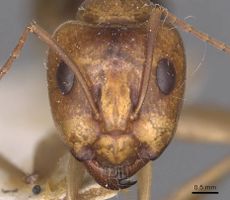 Camponotus discors major |
 Camponotus gibbinotus major |
51
return to couplet #47
- Larger species (HW ≈ 4 mm); in profile, metanotal groove a distinct notch (Figure 246) . . . . . Camponotus michaelseni . . . Camponotus tumidus
 Camponotus tumidus major |
- Smaller species (HW ≤ 3 mm); in profile metanotal groove indistinct or a small dimple (Figure 247) . . . . . 52
52
return to couplet #51
- Setae on venter of head capsule present . . . . . Camponotus claripes
- Setae on venter of head capsule absent . . . . . 53
53
return to couplet #52
- In full-face view, anteromedial clypeal margin with a weak notch, head triangular, expanded towards angles of vertex . . . . . Camponotus insipidus (in part - also #49)
- In full-face view, anteromedial clypeal margin either without notch, or head not triangular . . . . . 54
54
return to couplet #53
- In full-face view, mandibles short, compact, with five teeth (Figure 248) . . . . . Camponotus simpsoni
- In full-face view, mandibles of normal appearance, with six teeth or five strong teeth and additional denticle (Figure 249) . . . . . Camponotus darlingtoni
















